On the 6th of June, the day of the destruction of the Kakhovka dam, journalist Igor Burdyga arrived in Kherson. He returned to his hometown to document the devastating effects of the Dnipro's rising waters flooding the city. Burdyga’s firsthand account of the weeks that followed shows how, despite ruined homes, waist-high floods, and food shortages, Kherson’s residents are still finding reasons to smile.
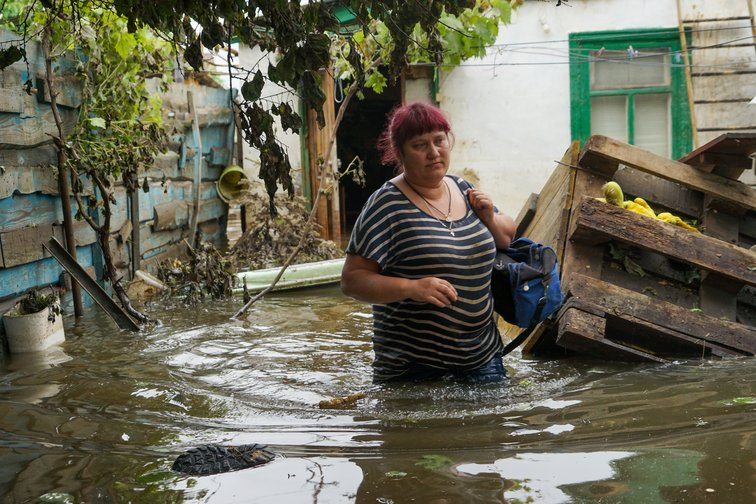 Flood in Kherson (picture Igor Burdyga)
Flood in Kherson (picture Igor Burdyga)
by Igor Burdyga
Lately, Max has asked me to bring him the same things from Kyiv every time I come to Kherson: canned cat food, a special brand of terrible cigarettes, and inexpensive fruit beer. You can buy all of this in the southern Ukrainian city but his schedule — he runs transport for the regional energy company — isn’t quite aligned with that of the supermarkets.
I grew up in Kherson, but these days I return as a journalist — to report on evacuations, liberation from Russian occupation, mass shelling, and the dam explosion. Together with my colleague Vladimir Senchenko, a cameraman, I manage to buy almost everything Max requested on our journey south.
We enter the city late on June 6, after the nightly curfew has begun. The next morning, a whole day has passed since the destruction of the Kakhovka dam. The city’s river-facing streets are gradually sinking into the water.
I have to drag the canned cat food and beer around with me all week. There is simply not enough time to deliver them to Max, though we rush several times a day past the old apartment block where he lives with his cats.
Still, my former classmate waits patiently. Max, it seems, is the only person who does not constantly message me with the same meaningless questions (“How are you?”, “What's going on there?”) in the course of this week. But on the third day of the explosion, literally a minute after Russian mines hit Kherson’s main evacuation point, Max gives in and calls to ask a short question: are you guys safe?
This past spring, Max lost two repair teams at his energy company, three people each: one team was blown up by a landmine, the second died in a shelling. Now, his apartment, frozen in the middle of a pre-war renovation, has become home to another colleague from work. Andriy used to live in Komyshany, a village outside Kherson, but since the Kakhovka dam explosion his house has been flooded.
A week after the explosion, Andriy shows me a photo on his phone of how the water level gradually rose, flooding the garden, sheds, and the outside kitchen he used in summer. He is interrupted by a call from his wife. She, like many other relatives of the electricians restoring Kherson’s infrastructure, is waiting out the war elsewhere. Kherson has been a frontline city since its liberation last November.
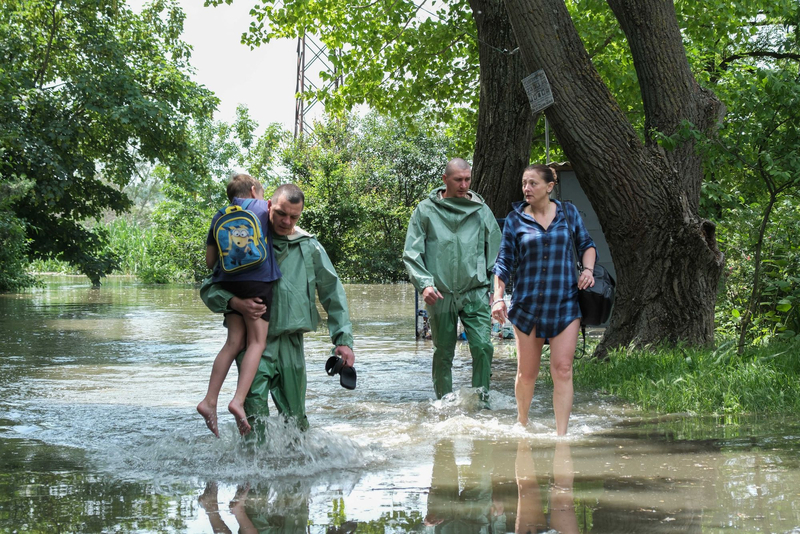 People evacuated after the Kakhovka explosion (picture Francis Farrell Kyiv Independent)
People evacuated after the Kakhovka explosion (picture Francis Farrell Kyiv Independent)
As Andriy goes into the other room to take the call, Max pours out the rest of the brandy that I brought him in the spring. We begin to recall the numerous horror stories, rumors, and legends that have swirled around the Kakhovka hydroelectric power station, dam, and reservoir since it was built in the mid-1950s.
“The last time they panicked a lot, I think, was in 2000,” Max smiles. “Everyone was afraid that the dam would break with a computer failure due to the millennium. Since then I remembered what the engineers told us: if the dam breaks, only the lower quarters of Kherson will be flooded, the right bank will get little at all. But honestly, I didn’t think that I would ever see it with my own eyes.”
Tsunami of fears
I understand what Max means. On the morning of June 7, together with a dozen residents at Kherson’s monument to Soviet soldiers who died in World War II, I watch huge poplar trees careering down the river, past the embankment, towards the Black Sea. Yesterday, two barges, which had broken loose from their anchors in the current, drifted past. I have never seen the Dnipro river run so fast, though I was born in this city 38 years ago and spent my childhood and teenage years here.
A granite staircase descends from the war monument to the embankment. For decades, this area served as a local concert venue, but now the bottom three flights are already under water and the level is still rising. On the faces of the townspeople, who have survived eight months of occupation and six months of shelling on the frontline, there is confusion and surprise.
Igor, my namesake, lives in one of the coastal neighborhoods nearby. After the dam’s destruction, he and many other residents were initially afraid of a mega tsunami. These can reach several hundred meters in height, travel at the speed of a jet plane and encroach up to 20 kilometers (12.4 miles) inland — they were a popular horror story doing the rounds locally. In reality, 60-year-old Igor watched all day as his mother’s house, which stood near the water, gradually flooded.
“Mom, you forgot to water the tomatoes,” he laughs, showing us the roof sticking out from under the water.
Kherson residents generally like to joke a lot: about the Russian occupation, Russian soldiers, the deadly shelling, and now, also about the flood. A popular object of ridicule is the flooded cesspools that have replaced the central sewer for residents of riverside neighborhoods. Toilet humor turns out to be a good cure for stress (I’ll spare you from those jokes here, though).
“I would like to note the kindness and positive attitude of the local residents,” Leonid Vozniuk, assistant professor of architecture and urban planning at Lviv Polytechnic, tells me enthusiastically in July, a month after the disaster. “We were offered water in three places today. They offer food, coffee. People who need help themselves offer things. This is a unique phenomenon in Ukraine.”
Vozniuk is walking around the houses on Tchaikovsky Street, in the center of the city, in the 40°C heat (104°F). He’s joined by a team of experts who are in Kherson to assess the extent of damage to private households. The air smells of rot and the notorious cesspools. Trash collectors, also seconded to Kherson from different regions, remove damp plaster, wallpaper, and other rubbish from the roadsides. Military chaplains from an evangelical church in Kyiv rush back and forth in buggies, pumping water out of basements and treating the walls with anti-mould chemicals.
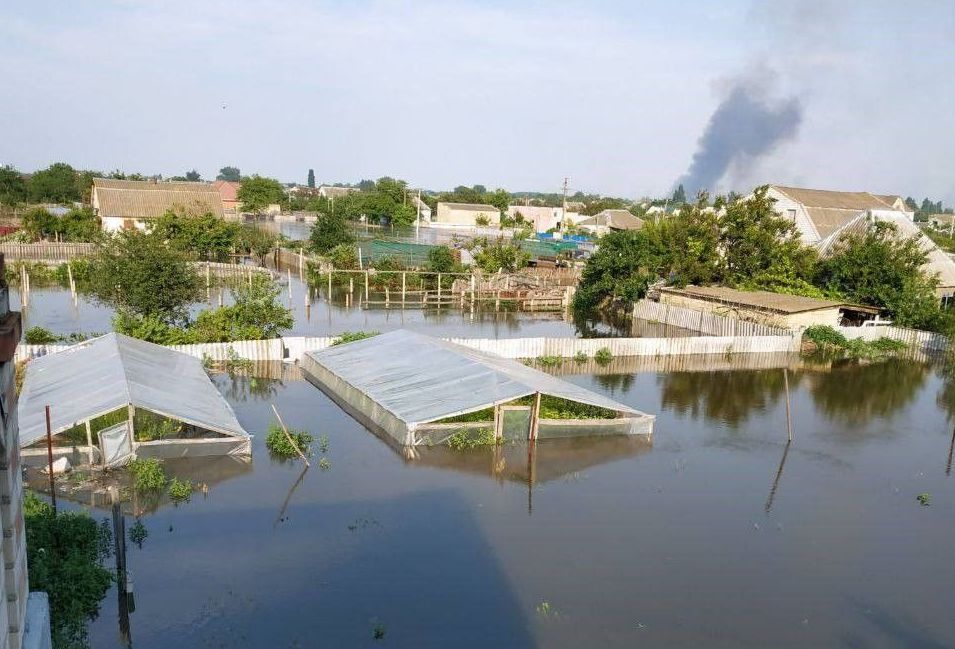 Flooding of village Oleshky in Kherson province (picture Telegram)
Flooding of village Oleshky in Kherson province (picture Telegram)
The conclusions of Vozniuk’s team are disappointing: three of the four houses they inspected today will need to be demolished. Having been underwater for several days, their old walls have become so damp they could collapse at any moment. The team leaves without finishing their inspection after the Russian military conducts a mass rocket attack on Lviv, their hometown.
We continue to joke even when small shrapnel begins to rain down on us.
With 51,000 houses flooded in Kherson and the area, thousands of people in the city have been left without a roof over their heads since the dam’s destruction. In a city with hardly a quarter of its pre-war population left, there is a short-term revival in the rental market: many do not want to move far from their flooded homes, hoping for speedy repairs. More than 3,100 households have applied for government assistance as of July 12.
Meanwhile, there is little information about the scale of destruction on the lower left bank of the Dnipro, which is under control of the Russian army. Since the dam’s destruction, Ukrainian special forces have organized several rescue missions, transporting the inhabitants of the left-bank towns of Oleshky, Hola Prystan, and Kardashynka to safety. On June 11, Russian soldiers opened fire on one of these boats. Three people were killed and 10 wounded and taken to hospitals in Kherson.
Finding evacuees in the first days was not easy. The Kherson regional administration tried to keep the location of temporary shelters in schools and dormitories a secret. Everyone feared the shelters will become a target for attacks: they expect no mercy from the Russian army, which until recently called Kherson an “integral part” of Russia.
Shell shock
When I receive Max’s worried call just after Kherson is hit by the first large-scale shelling since the dam breach three days earlier, I am with two colleagues on Bohorodytska Street, in the city center. Just half an hour beforehand, we had found a small rubber boat in an alley and, with the neighbors’ consent, gone into the water in it. When Max phones, we are anchored against the second-floor wall of someone’s mansion, standing frightened in the boat.
Of course, we are looking for a joke: as a former reporter on Ukraine’s telecommunications sector, I am appointed head of communications and hold on tightly to an internet cable so we are not washed away by the current. But the laughter doesn’t stop there. We laugh when more successful colleagues rush past us on motorboats; we laugh when we pick ripe mulberries from the tops of trees; we laugh when the first Russian mines fly over us and explode on Korabelov Square; we laugh when one of them hits a house 30 meters (32 yards) from us. A subsequent volley of Grad rockets makes us feel unsure, but we continue to joke even when small shrapnel begins to rain down on us.
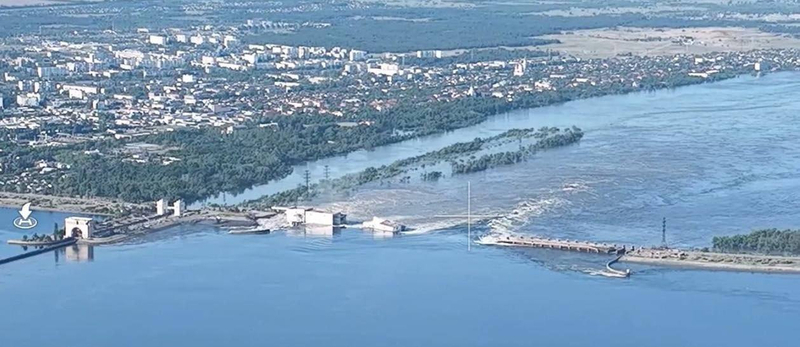 The blasting of the Kakhova dam (picture Energoatom)
The blasting of the Kakhova dam (picture Energoatom)
A huge number of journalists came to Kherson in that first week after the dam’s destruction. Perhaps even more than in November, when the city was liberated by the Ukrainian army. After the shelling, our group chat was filled with a roll call: Is everyone safe? Who managed to film the shelling?
It’s been five weeks since the dam was destroyed. The shelling of the city has not stopped for even a single day.
The first Russian strike on Korabelov Square, the one Max calls me after, seems pointless. President Volodymyr Zelensky, who visited the city that day, had left the square three hours earlier. By the time of the strike, it is just one of the city’s main evacuation points. In the following days, the counter-battery fight does not subside over the city. Ukrainian artillerymen shoot, trying to drive the Russian military away from the left bank of the river. At one point, they even occupy a bridgehead near Oleshky.
The nights pass to the accompaniment of artillery salvoes and the barking of a neighbor’s dog, which has gone completely crazy. Over the long months of war, the dog has learned to change its tone depending on the rate of fire and caliber of the shells. There are not enough hotel beds for everyone, so seven or eight of my colleagues now spend every night in my house, which had been empty since the beginning of the war.
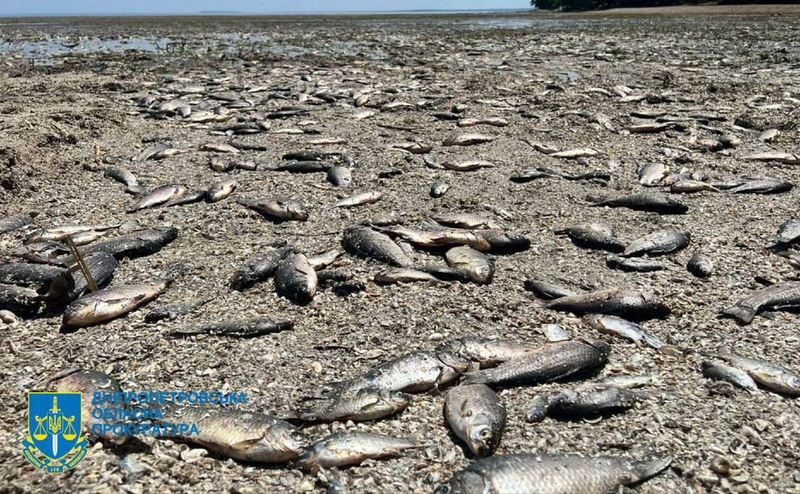 Results of the Kakhovka flood (picture twitter)
Results of the Kakhovka flood (picture twitter)
No one has time to eat during the day, so my colleague and I prepare dinners that stretch on for hours. There is an exchange of stories about the day, plans for tomorrow, disputes about fees for stories, discussions over whether to wear body armor in a boat during shelling (we decide no, it’s not worth it), and stories from a past life, with some exchanging photos of our children.
Desperate times
Volunteers also come to the flooded city en masse in the first week. Some bring boats, until now a rarity; some bring medicine; some just a full minivan of drinking water. Ihor Kiyashko, the head of the Vezha social assistance charity, is trying to coordinate numerous groups in an impromptu camp halfway between Kherson and Mykolaiv, a city a little over an hour away.
Kiyashko, a giant guy with a beard, describes the situation briefly: “People have a noble impulse, but there is little understanding of [people’s] needs and how to do it. Therefore, many turn back without finding something to do.”
As if in illustration, I see a guy who loaned us a boat for our live broadcast on our fourth day in Kherson chasing a stray cat down the street for a selfie: “Kitty, kitty, come here. If they ask, please tell everyone that I saved you.”
Animals are rescued with no less enthusiasm than people. On Korabel, an island within the city that is now flooded, several teams of animal welfare volunteers remove domestic dogs and cats from the roofs and catch strays. Feral animals, frightened by floods and shelling, do not come lightly. For that, you need a tranquiliser gun, says Volodya Starchenkov.
People help with what is easier to deliver – food, water. But we need medicine and at least some kind of X-ray
Once upon a time, even before moving to Kyiv, I worked as a bartender in a club that belonged to Volodya’s family. Later, I stayed more than once at their hotel on Ukraine’s Black Sea coast. Volodya was an inexhaustible source of stories about the local tourism business. Today, as throughout the occupation of Kherson, he and his wife, Sveta, run a veterinary clinic. They treat and sterilize homeless animals, and now, they are taking the island’s dogs to their shelter by boat. A week later, both collapse with a cold and overwork, and we barely have time to meet before I leave.
Volodya and Sveta take us to the animal enclosures. A couple of days ago they sent most of the animals to Lviv, to a shelter run by a partner organization. Only a dozen or so crippled, shabby, and nervous watch dogs remained. One MP promised to adopt a large mongrel, called Tolstoy, after the dog’s rescue video went viral a few days ago, and a parliamentary delegation brought a mountain of food to the shelter. “People help with what is easier to deliver — food, water. But we need medicine and at least some kind of X-ray,” Sveta complains.
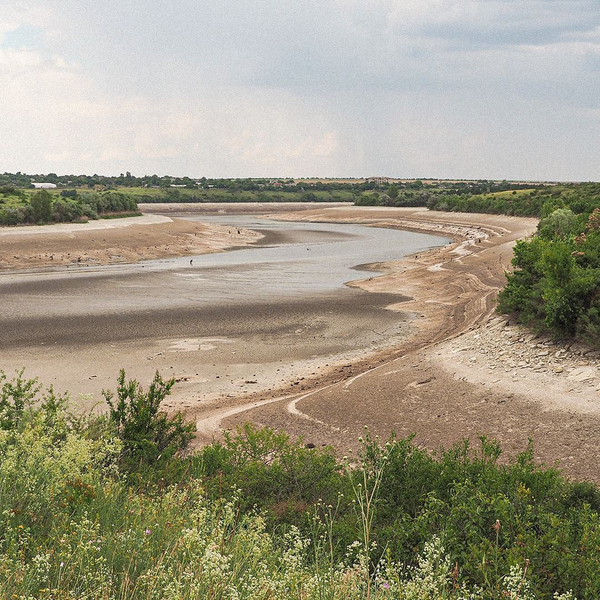
The war has made the people of Kherson tight-fisted and thrifty. A week after the dam broke, Svetlana Tsvetkova, waist deep in water, dragged bags of pasta and flour from the attic of her house — humanitarian supplies that are now filling the trunks of neighbors’ old Zhiguli cars. She and her husband managed to store them on shelves above the flood line in the first hours of the flooding. “My husband started drinking from the stress,” she laughs.
Few people in Kherson refuse humanitarian aid. Life on the frontline does not give you much confidence in the future, and there is not enough work for everyone. But there is a special attitude towards flood victims: material assistance from the government and the UN, separate queues for free water, bread, food.
In the first week, several families flatly refused to evacuate their flooded homes on Korabel island. They were brought food and water by volunteers I know, who were collecting animals from neighboring yards. The volunteers complained that people were already being choosy about the food they are given; soon, they might start ordering vodka, they said with grim humor. By the end of the week, my companions found a yellow bag belonging to one of the major delivery companies lying in the street and jokingly suggested getting a delivery from McDonald’s in Odesa, a four-hour drive away.
Twenty-one people died during the evacuation of Kherson. Thirty people are still missing. It’s impossible to arrive at a total number of casualties due to the dam explosion — there is no confirmed information about what happened in territory under Russian occupation.
It’s been five weeks since the dam was destroyed. The shelling of the city has not stopped for even a single day.
This piece was published on the 13th of July 2023 on openDemocracy.
